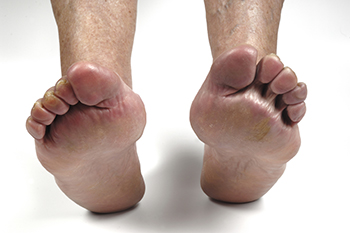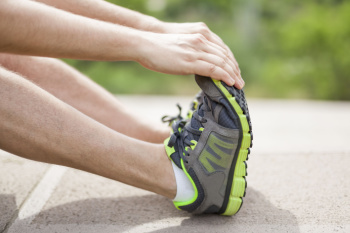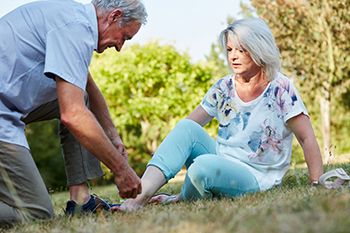Connect With Us
Blog
Items filtered by date: March 2024
Causes, Symptoms, and Treatment of Bunions

Bunions, technically known as hallux valgus, are bony bumps that form at the base of the big toe joint. They are caused by a structural problem within the foot bones, often the metatarsophalangeal, or MTP, joint. This causes the big toe to angle toward the second toe instead of pointing straight ahead, leading to discomfort and mobility issues. While genetics play a role in the development of bunions, factors like overpronation, foot injuries, arthritis, and nerve or muscle conditions can contribute to bunion development. Symptoms include pain, inflammation, and difficulty wearing certain shoes. Conservative treatment, like supportive footwear and pain-relieving medication, are initial options. Cortisone injections may be used for swelling and pain. However, when conservative measures fail, surgical intervention may be necessary to realign the joint and relieve pain. Bunion surgery is typically reserved for severe cases where pain and deformity persist despite other treatments. If you're experiencing bunion pain, it is suggested that you make an appointment with a podiatrist who can provide personalized treatment options.
If you are suffering from bunion pain, contact one of our podiatrists of Southwest Podiatry. Our doctors can provide the care you need to keep you pain-free and on your feet.
What Is a Bunion?
Bunions are painful bony bumps that usually develop on the inside of the foot at the joint of the big toe. As the deformity increases over time, it may become painful to walk and wear shoes. Women are more likely to exacerbate existing bunions since they often wear tight, narrow shoes that shift their toes together. Bunion pain can be relieved by wearing wider shoes with enough room for the toes.
Causes
- Genetics – some people inherit feet that are more prone to bunion development
- Inflammatory Conditions - rheumatoid arthritis and polio may cause bunion development
Symptoms
- Redness and inflammation
- Pain and tenderness
- Callus or corns on the bump
- Restricted motion in the big toe
In order to diagnose your bunion, your podiatrist may ask about your medical history, symptoms, and general health. Your doctor might also order an x-ray to take a closer look at your feet. Nonsurgical treatment options include orthotics, padding, icing, changes in footwear, and medication. If nonsurgical treatments don’t alleviate your bunion pain, surgery may be necessary.
If you have any questions, please feel free to contact our offices located in Dallas, and Carrollton, TX . We offer the newest diagnostic and treatment technologies for all your foot care needs.
Why Live with Pain and Numbness in Your Feet?
Foot Pain and Rheumatoid Arthritis

Foot pain is often one of the earliest signs of rheumatoid arthritis, or RA, an autoimmune condition affecting joints. RA can manifest in various forms in the feet, including swelling, stiffness, and tenderness. Over time, untreated RA can lead to progressive foot deformities such as bunions, hammertoes, and rheumatoid nodules. Additionally, inflammation in the joints can cause joint erosion and instability, further exacerbating foot problems. Seeking care from a podiatrist is necessary for individuals with RA, as these doctors specialize in managing foot conditions associated with arthritis. Podiatrists can provide comprehensive assessments, including gait analysis and imaging studies, to identify specific foot issues related to RA. If you suffer from RA symptoms in your feet, it is strongly suggested that you are under the care of a podiatrist who can help you maintain mobility and a better quality of life.
Because RA affects more than just your joints, including the joints in your feet and ankles, it is important to seek early diagnosis from your podiatrist if you feel like the pain in your feet might be caused by RA. For more information, contact one of our podiatrists of Southwest Podiatry. Our doctors will assist you with all of your podiatric concerns.
What Is Rheumatoid Arthritis?
Rheumatoid Arthritis (RA) is an autoimmune disorder in which the body’s own immune system attacks the membranes surrounding the joints. Inflammation of the lining and eventually the destruction of the joint’s cartilage and bone occur, causing severe pain and immobility.
Rheumatoid Arthritis of the Feet
Although RA usually attacks multiple bones and joints throughout the entire body, almost 90 percent of cases result in pain in the foot or ankle area.
Symptoms
- Swelling and pain in the feet
- Stiffness in the feet
- Pain on the ball or sole of feet
- Joint shift and deformation
Diagnosis
Quick diagnosis of RA in the feet is important so that the podiatrist can treat the area effectively. Your doctor will ask you about your medical history, occupation, and lifestyle to determine the origin of the condition. Rheumatoid Factor tests help to determine if someone is affected by the disease.
If you have any questions please feel free to contact our offices located in Dallas, and Carrollton, TX . We offer the newest diagnostic and treatment technologies for all your foot and ankle needs.
Essential Stretches for Runners to Prevent Injuries

In the pursuit of their passion, runners understand the importance of injury prevention through targeted stretching routines. Among the essential stretches for runners are calf stretches, which involve gently leaning forward against a wall to elongate the calf muscles and Achilles tendon. Another effective stretch is the quadriceps stretch, achieved by standing on one leg and pulling the opposite foot toward the glutes, helping to alleviate tension in the front thigh muscles. Hamstring stretches, performed while sitting or standing, aid in maintaining flexibility and reducing strain on the back of the thighs. Runners also benefit from incorporating dynamic stretches into their warm-up routines, such as leg swings and high knees, to increase blood flow and prepare the muscles for activity. By incorporating these stretches into their regimen, runners can help prevent injuries that may affect their feet. If you are interested in learning about additional stretches that can help prevent injuries, it is suggested that you consult a podiatrist.
Exercising your feet regularly with the proper foot wear is a great way to prevent injuries. If you have any concerns about your feet, contact one of our podiatrists of Southwest Podiatry. Our doctors will treat your foot and ankle needs.
How to Prevent Running Injuries
Many common running injuries are caused by overuse and overtraining. When the back of the kneecap starts wearing out and starts causing pain in your knee, this is commonly referred to as runner’s knee. Runner’s knee is a decrease in strength in your quadriceps and can occur if you’re not wearing properly fitted or supporting shoes. To prevent runner’s knee, focusing on hip strengthening is a good idea, as well as strengthening your quads to keep the kneecaps aligned.
What Are Some Causes of Running Injuries?
- One cause of a common running injury is called iliotibial band syndrome.
- Plantar fasciitis is also another common injury.
- Stress fractures can occur from overtraining, lack of calcium, or even your running style.
Best Ways to Prevent Running Injuries
- Wear footwear that fits properly and suits your running needs.
- Running shoes are the only protective gear that runners have to safeguard them from injury.
- Make a training schedule. Adding strengthening exercises as well as regular stretching can help keep you strong and limber and can lessen the possibility of injuries.
- Stretching keeps muscles limber; this will help you gain better flexibility.
If you have any questions please feel free to contact our offices located in Dallas, and Carrollton, TX . We offer the newest diagnostic and treatment technologies for all your foot and ankle needs.
Causes of Foot Pain in the Elderly
 Foot pain is a common experience during the aging process. Common causes of foot pain in older people include changes in foot structure, decreased cushioning in the soles of the feet, and a natural reduction in skin elasticity. Conditions like arthritis, which become more prevalent with age, can contribute to joint pain and inflammation in the feet. Older people often experience lowered circulation and slower healing processes, which can make foot problems worse. Chronic conditions such as diabetes can also lead to neuropathy, causing tingling, numbness, and pain in the feet. It is important to choose the right footwear and practice good foot hygiene to prevent any additional pain. If you are experiencing foot pain as an older adult, it is suggested you consult with a podiatrist who can offer a diagnosis for foot pain and management techniques.
Foot pain is a common experience during the aging process. Common causes of foot pain in older people include changes in foot structure, decreased cushioning in the soles of the feet, and a natural reduction in skin elasticity. Conditions like arthritis, which become more prevalent with age, can contribute to joint pain and inflammation in the feet. Older people often experience lowered circulation and slower healing processes, which can make foot problems worse. Chronic conditions such as diabetes can also lead to neuropathy, causing tingling, numbness, and pain in the feet. It is important to choose the right footwear and practice good foot hygiene to prevent any additional pain. If you are experiencing foot pain as an older adult, it is suggested you consult with a podiatrist who can offer a diagnosis for foot pain and management techniques.
Foot Pain
Foot pain can be extremely painful and debilitating. If you have a foot pain, consult with one of our podiatrists from Southwest Podiatry. Our doctors will assess your condition and provide you with quality foot and ankle treatment.
Causes
Foot pain is a very broad condition that could be caused by one or more ailments. The most common include:
- Bunions
- Hammertoes
- Plantar Fasciitis
- Bone Spurs
- Corns
- Tarsal Tunnel Syndrome
- Ingrown Toenails
- Arthritis (such as Gout, Rheumatoid, and Osteoarthritis)
- Flat Feet
- Injury (from stress fractures, broken toe, foot, ankle, Achilles tendon ruptures, and sprains)
- And more
Diagnosis
To figure out the cause of foot pain, podiatrists utilize several different methods. This can range from simple visual inspections and sensation tests to X-rays and MRI scans. Prior medical history, family medical history, and any recent physical traumatic events will all be taken into consideration for a proper diagnosis.
Treatment
Treatment depends upon the cause of the foot pain. Whether it is resting, staying off the foot, or having surgery; podiatrists have a number of treatment options available for foot pain.
If you have any questions, please feel free to contact our offices located in Dallas, and Carrollton, TX . We offer the newest diagnostic and treatment technologies for all your foot care needs.

